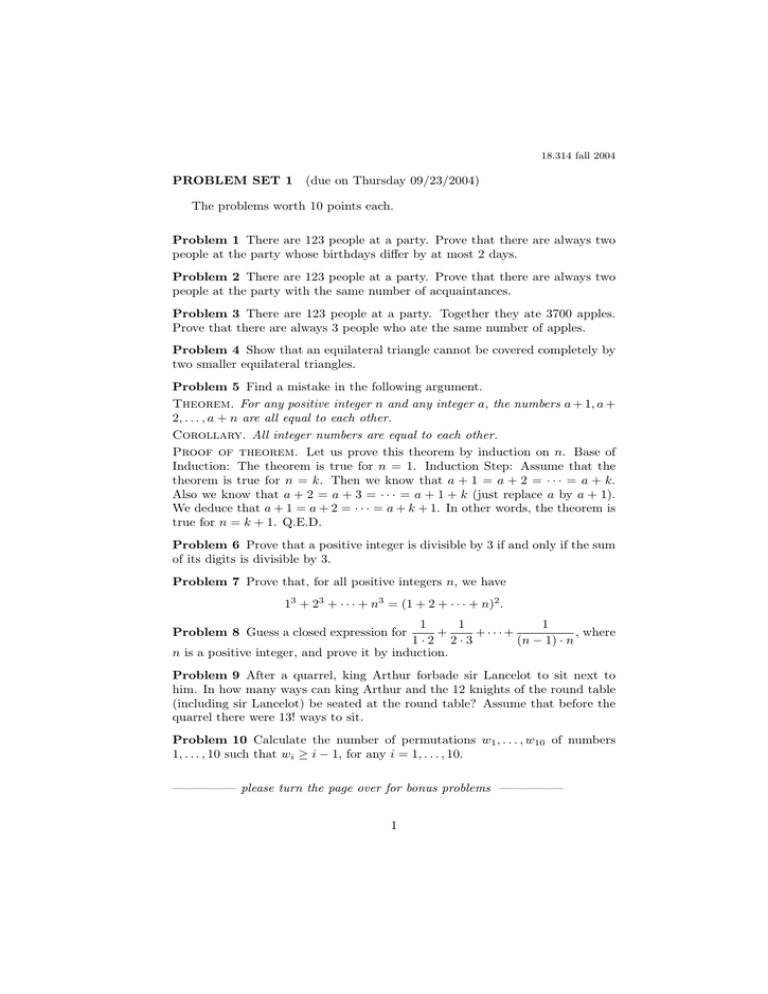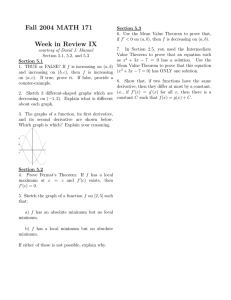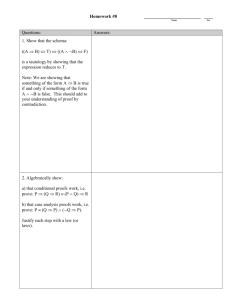PROBLEM SET 1 (due on Thursday 09/23/2004)
advertisement

18.314 fall 2004 PROBLEM SET 1 (due on Thursday 09/23/2004) The problems worth 10 points each. Problem 1 There are 123 people at a party. Prove that there are always two people at the party whose birthdays differ by at most 2 days. Problem 2 There are 123 people at a party. Prove that there are always two people at the party with the same number of acquaintances. Problem 3 There are 123 people at a party. Together they ate 3700 apples. Prove that there are always 3 people who ate the same number of apples. Problem 4 Show that an equilateral triangle cannot be covered completely by two smaller equilateral triangles. Problem 5 Find a mistake in the following argument. Theorem. For any positive integer n and any integer a, the numbers a + 1, a + 2, . . . , a + n are all equal to each other. Corollary. All integer numbers are equal to each other. Proof of theorem. Let us prove this theorem by induction on n. Base of Induction: The theorem is true for n = 1. Induction Step: Assume that the theorem is true for n = k. Then we know that a + 1 = a + 2 = · · · = a + k. Also we know that a + 2 = a + 3 = · · · = a + 1 + k (just replace a by a + 1). We deduce that a + 1 = a + 2 = · · · = a + k + 1. In other words, the theorem is true for n = k + 1. Q.E.D. Problem 6 Prove that a positive integer is divisible by 3 if and only if the sum of its digits is divisible by 3. Problem 7 Prove that, for all positive integers n, we have 13 + 23 + · · · + n3 = (1 + 2 + · · · + n)2 . 1 1 1 + +· · ·+ , where 1·2 2·3 (n − 1) · n n is a positive integer, and prove it by induction. Problem 8 Guess a closed expression for Problem 9 After a quarrel, king Arthur forbade sir Lancelot to sit next to him. In how many ways can king Arthur and the 12 knights of the round table (including sir Lancelot) be seated at the round table? Assume that before the quarrel there were 13! ways to sit. Problem 10 Calculate the number of permutations w1 , . . . , w10 of numbers 1, . . . , 10 such that wi ≥ i − 1, for any i = 1, . . . , 10. ————— please turn the page over for bonus problems ————— 1 Problem 11 (*) (a) Show that, for any permutation w1 , . . . , w10 of numbers 1, . . . , 10, we can always pick a subsequence wa , wb , wc , wd (a < b < c < d) of 4 numbers such that either wa < wb < wc < wd or wa > wb > wc > wd . For example, for 3, 1, 5, 7, 2, 4, 10, 6, 8, we can pick 3 < 5 < 7 < 10. (b) For any positive m and n, show that a permutation of numbers 1, . . . , m·n+1 always contains either an increasing subsequence of length m + 1 or a decreasing subsequence of length n + 1. Problem 12 (*) (a) Calculate the number of ways to place 16 kings on an 8 × 8 chessboard so that no two kings attack each other. (b) Generalize this to an arbitrary rectangular m × n board. Find the maximal number N of nonattacking kings that can be placed on the m × n board. Calculate the number of placements of N nonattacking kings on the board. 0 Problems marked with (*) are optional bonus problems. 2






